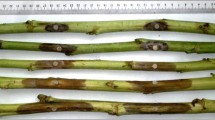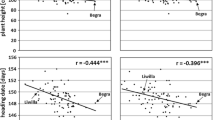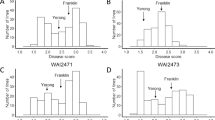Abstract
Drought is the major constraint to chickpea (Cicer arietinum L.) productivity worldwide. Utilizing early-flowering genotypes and advancing sowing from spring to autumn have been suggested as strategies for drought avoidance. However, Ascochyta blight (causal agent: Didymella rabiei (Kov.) v. Arx.) is a major limitation for chickpea winter cultivation. Most efforts to introgress resistance to the pathogen into Kabuli germplasm resulted in relatively late flowering germplasm. With the aim to explore the feasibility of combining earliness and resistance, RILs derived from a cross between a Kabuli cultivar and a Desi accession were evaluated under field conditions and genotyped with SSR markers. Three quantitative trait loci (QTLs) with significant effects on resistance were identified: two linked loci located on LG4 in epistatic interaction and a third locus on LG8. Two QTLs were detected for time to flowering: one in LG1 and another on LG2. When resistance and time to flowering were analyzed together, the significance of the resistance estimates obtained for the LG8 locus increased and the locus effect on days to flowering, previously undetected, was significantly different from zero. The identification of a locus linked both to resistance and time to flowering may account for the correlation observed between these traits in this and other breeding attempts.



Similar content being viewed by others
Abbreviations
- LOD:
-
Logarithm of the odds of linkage between two loci
- PEV:
-
Proportion of explained phenotypic variance
- QTL:
-
Quantitative trait locus (QTLs for loci)
- RDR:
-
Relative response to Didymella rabiei
- RIL:
-
Recombinant inbred line (RILs for lines)
- SSR:
-
Simple sequence repeat
- tRAUDPC:
-
Arcsin transformed area under the disease progress curve
References
Benjamini Y, Hochberg Y (1995) Controlling the false discovery rate: a practical and powerful approach to multiple testing. J Roy Statist Soc B 57:289–300
Cho S, Chen W, Muehlbauer FJ (2004) Pathotype-specific genetic factors in chickpea (Cicer arietinum L.) for quantitative resistance to Ascochyta blight. Theor Appl Genet 109:733–739
Cho S, Kumar J, Shultz JL, Anupama K, Tefera F, Muehlbauer FJ (2002) Mapping genes for double podding and other morphological traits in chickpea. Euphytica 128:285–292
Churchill GA, Doerge RW (1994) Empirical threshold values for quantitative trait mapping. Genetics 138: 963–971
Collard BCY, Pang ECK, Ades PK, Taylor PWJ (2003) Preliminary investigation of QTLs associated with seedling resistance to Ascochyta blight form Cicer echinospermum, a wild relative of chickpea. Theor Appl Genet 107:719–729
Elazari-Volcani I (1930) The Fellah’s Farm. Bulletin No. 10. Institute of Agriculture and Natural History, The Jewish Agency for Palestine, Tel-Aviv
FAO (2005) Statistical database. At: http://www.fao.org
Flandez-Galvez H, Ford R, Pang ECK, Taylor PWJ (2003) An intraspecific linkage map of the chickpea (Cicer arietinum L.) genome based on sequence tagged microsatellite and resistance gene analogue markers. Theor Appl Genet 106:1447–1456
Kaiser WJ (1992) Epidemiology of Ascochyta rabiei. In: Singh KB, Saxena MC (eds) Disease Resistance Breeding in Chickpea—Proceedings of the Consultative Meeting on Breeding for Disease Resistance in Kabuli Chickpea. ICARDA - International Centre for Agricultural Research in the Dry Areas, Aleppo, pp 117–134
Korol AB, Ronin YI, Kirzhner VM (1995) Interval mapping of quantitative trait loci employing correlated trait complexes. Genetics 140:1137–1147
Korol AB, Ronin YI, Tadmor Y, Bar-Zur A, Kirzhner VM, Nevo E (1996) Estimating variance effect of QTL: an important prospect to increase the resolution power of interval mapping. Genet Research 67:187–194
Kostrinski J (1974) Problems in chickpea cultivation and grain crop rotation in Israel. Special publication of the Agriculture Research Organization, Volcani Centre No. 34, 51 (In Hebrew, English summary)
Kuehl RO (2000) Variance-stabilizing transformations for data with known distributions. In: Design of experiments—statistical principles of research design and analysis. Duxbury Press, Pacific Grove, pp 133–134
Kumar J, Abbo S (2001) Genetics of flowering time in chickpea and its bearing on productivity in the semi-arid environments. Adv Agron 72:107–138
Ladizinsky G (1995) Chickpea. In: Smart J, Simmonds NW (eds) Evolution of crop plants. Longman, London, pp 258–261
Lander ES, Green P, Abrahamson J, Barlow A, Daly J, Lincoln SE, Newsburg L (1987) MAPMAKER: an interactive computer package for constructing primary genetic linkage maps of experimental populations. Genomics 1:174–181
Lev-Yadun S, Gopher A, Abbo S (2000) The cradle of agriculture. Science 288:1602–1603
Lichtenzveig J, Gamliel E, Frenkel O, Michaelido S, Abbo S, Sherman A, Shtienberg D (2005a) Distribution of mating types and diversity in virulence of Didymella rabiei in Israel. Europ J Plant Pathol 113:15–24
Lichtenzveig J, Scheuring C, Dodge J, Abbo S, H-B Zhang (2005b) Construction of BAC and BIBAC libraries and their applications for generation of SSR markers for genome analysis of chickpea, Cicer arietinum L. Theor Appl Genet 110:492–510
Lichtenzveig J, Shtienberg D, Zhang H-B, Bonfil DJ, Abbo S (2002) Biometric analyses of the inheritance of resistance to Didymella rabiei in chickpea. Phytopathology 92:417–423
Lynch M, Walsh B (1998) Estimation of the genetic correlation. In: Genetics and analysis of quantitative traits. Sinauer Associates Inc., Sunderland pp 632–637
Miller PR, McConkey BG, Clayton GW, Brandt SA, Staricka JA, Johnston AM, Lafond G, Schatz BG, Baltensperger DD, Neill K (2002) Pulse crop adaptation in the Northern Great Plains. Agron J 94:261–272
Or E, Hovav R, Abbo S (1999) A major gene for flowering time in chickpea. Crop Sci 39:315–322
Pande S, Siddique KHM, Kishore GK, Bayaa B, Gaur PM, Gowda CLL, Bretag TW, Crouch JH (2005) Ascochyta blight of chickpea (Cicer arietinum L.): a review of biology, pathogenicity, and disease management. Aust J Agric Res 56:317–332
Peng J, Ronin Y, Fahima T, Roder MS, Li Y, Nevo E, Korol A (2003) Domestication quantitative trait loci in Triticum dicoccoides, the progenitor of wheat. Proc Natl Acad Sci USA 100:2489–2494
Pfaff TT, Kahl G (2003) Mapping of gene-specific markers on the genetic map of chickpea (Cicer arietinum L.). Mol Genet Genomics 269:243–251
Ronin YI, Korol AB, Nevo E (1999) Single- and multiple-trait mapping analysis of linked quantitative trait loci: some asymptotic analytical approximations. Genetics 151:387–396
Santra DK, Tekeoglu M, Ratnaparkhe M, Kaiser WJ, Muehlbauer FJ (2000) Identification and mapping of QTLs conferring resistance to Ascochyta blight in chickpea. Crop Sci 40:1606–1612
Shtienberg D, Vintal H, Brener S, Retig B (2000) Rational management of Didymella rabiei in chickpea by integration of genotype resistance and post infection application of fungicides. Phytopathology 90:834–842
Singh KB, Malhotra RS, Saxena MC, Bejiga G (1997) Superiority of winter sowing over traditional spring sowing of chickpea in the Mediterranean region. Agron J 89:112–118
Singh KB, Reddy MV (1996) Improving chickpea yield by incorporating resistance to Ascochyta blight. Theor Appl Genet 92:509–515
Tekeoglu M, Rajesh PN, Muehlbauer F (2002) Integration of sequence tagged microsatellite sites to the chickpea genetic map. Theor Appl Genet 105:847–854
Turner NC, Wright GC, Siddique KHM (2001) Adaptation of grain legumes (pulses) to water limited environments. Adv Agron 71:193–231
Vir S, Grewal JS, Gupta VP (1975) Inheritance of resistance to Ascochyta blight in chickpea. Euphytica 24:209–211
Winter P, Benko-Iseppo AM, Hüttel B, Ratnaparkhe M, Tullu A, Sonnante G, Pfaff T, Tekeoglu M, Santra D, Sant VJ, Rajesh PN, Kahl G, Muehlbauer FJ (2000) A linkage map of the chickpea (Cicer arietinum L.) genome based on recombinant inbred lines from a C. arietinum × C. reticulatum cross Localization of resistance genes for Fusarium wilt races 4 and 5. Theor Appl Genet 101:1155–1163
Winter P, Pfaff T, Udupa SM, Hüttel B, Sharma PC, Sahi S, Arreguin-Espinoza R, Weigand F, Muehlbauer FJ, Kahl G (1999) Characterization and mapping of sequence-tagged microsatellite sites in the chickpea (Cicer arietinum L.) genome. Mol Gen Genet 262:90–101
Young ND (1996) QTL mapping and quantitative disease resistance in plants. Annu Rev Phytopathol 34:479–501
Acknowledgments
This research was supported in part by Research Grant Award US-3034-98R from The United States-Israel Binational Agricultural Research and Development Fund (BARD) awarded to S. Abbo, D. J. Bonfil, and H.-B. Zhang. The authors thank Mrs. H. Van-Oss for her skilful assistance in SSR genotyping, Mr. David Carlebakh and Agr. Israel Shai (Massuot-Yitzchak), Mr. Israel Mufradi and Mr. Saker El-Atrash (Gilat Station) and Dr. Pfaff for their assistance in the field experiments. The authors would also like to thank Prof. Cahaner and Prof. Korol for their professional advice.
Author information
Authors and Affiliations
Corresponding author
Additional information
Communicated by J.-L. Jannink.
Rights and permissions
About this article
Cite this article
Lichtenzveig, J., Bonfil, D.J., Zhang, HB. et al. Mapping quantitative trait loci in chickpea associated with time to flowering and resistance to Didymella rabiei the causal agent of Ascochyta blight. Theor Appl Genet 113, 1357–1369 (2006). https://doi.org/10.1007/s00122-006-0390-3
Received:
Accepted:
Published:
Issue Date:
DOI: https://doi.org/10.1007/s00122-006-0390-3




